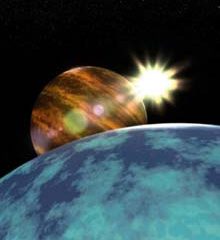This area deals with the fundamental laws and building blocks of nature and how they interact, the properties and the behavior of matter, and research into space and time and their structures.
innovations-report provides in-depth reports and articles on subjects such as astrophysics, laser technologies, nuclear, quantum, particle and solid-state physics, nanotechnologies, planetary research and findings (Mars, Venus) and developments related to the Hubble Telescope.

The Heisenberg uncertainty principle places severe constraints on the subatomic world. To illustrate, for particles called bosons, the principle dictates that bosons either condense to form a superconductor or they must remain localized in an insulator. However, experiments conducted during the last 15 years on thin films have revealed a third possibility: Bosons can exist as a metal. Scientists have been struggling to interpret this surprising result.
“The conventional theory of metals is

Physicists are getting more involved in the fight against diseases by studying the folding of proteins, which they hope will eventually lead to the development of new drugs. Illnesses such as Alzheimer’s disease and even some cancers are the result of protein folding that has gone awry. Since proteins in the body perform different functions according to their shape, the folding process is considered a very important area of study.
Everett Lipman, a new assistant professor of physics at

ESA is now planning a mission that can detect moons around planets outside our Solar System, those orbiting other stars!
Everyone knows our Moon: lovers stare at it, wolves howl at it, and ESA recently sent SMART-1 to study it. But there are over a hundred other moons in our Solar System, each a world in its own right.
A moon is a natural body that travels around a planet. Moons are a by-product of planetary formation and can range in size from small asteroid-sized bodies of a f

A team of researchers at the University of Colorado at Boulder has taken another step in the quest to build a compact, tabletop x-ray microscope that could be used for biological imaging at super-high resolution.
By firing a femtosecond laser – a laser that generates light pulses with durations as short as 100 trillionth of a second – through a gas-filled tube called a waveguide, they were able to create more efficient “laser-like” beams in regions of the spectrum that were previously inacc

A PhD student from Loughborough University has discovered why biscuits sometimes break-up after being baked. Published today in the Institute of Physics journal Measurement Science and Technology this discovery will help manufacturers work out how to make the perfect biscuit.
Biscuits such as the “Rich Tea” type sometimes develop cracks spontaneously up to a few hours after baking, making the biscuit liable to break under the application of small loads such as being packaged or transported t

New research on the sun’s contribution to global warming is reported in this month’s Astronomy & Geophysics. By looking at solar activity over the last 11,000 years, British Antarctic Survey (BAS) astrophysicist, Mark Clilverd, predicts that the sun’s contribution to warming the Earth will reduce slightly over the next 100 years.
This is a different picture to the last century when solar flares, sunspots and geomagnetic storms, increased in number. This rise is simultaneous with emissions of